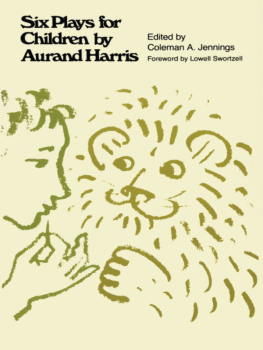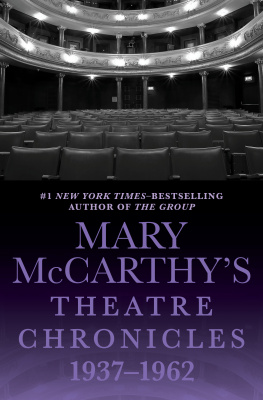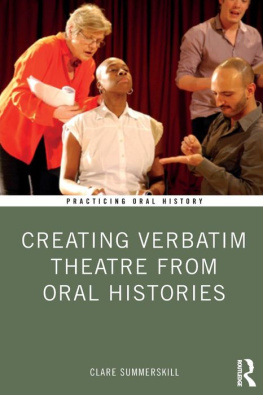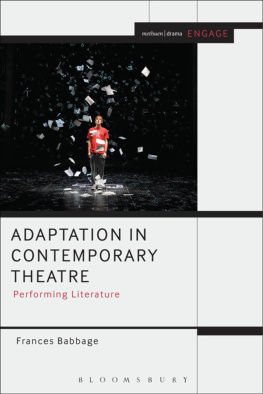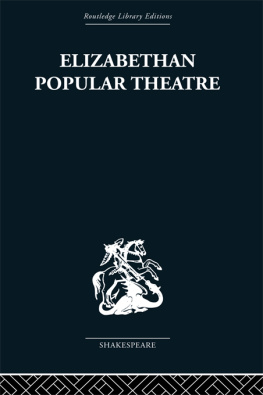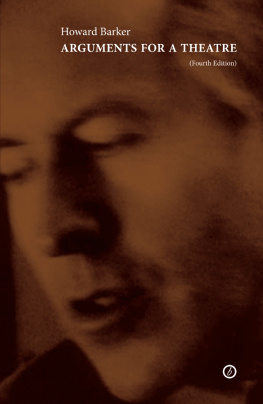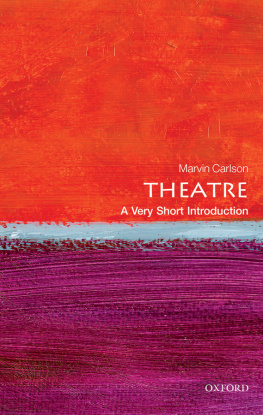Aurand Harris - Six Plays for Children
Here you can read online Aurand Harris - Six Plays for Children full text of the book (entire story) in english for free. Download pdf and epub, get meaning, cover and reviews about this ebook. year: 2014, publisher: University of Texas Press, genre: Detective and thriller. Description of the work, (preface) as well as reviews are available. Best literature library LitArk.com created for fans of good reading and offers a wide selection of genres:
Romance novel
Science fiction
Adventure
Detective
Science
History
Home and family
Prose
Art
Politics
Computer
Non-fiction
Religion
Business
Children
Humor
Choose a favorite category and find really read worthwhile books. Enjoy immersion in the world of imagination, feel the emotions of the characters or learn something new for yourself, make an fascinating discovery.
- Book:Six Plays for Children
- Author:
- Publisher:University of Texas Press
- Genre:
- Year:2014
- Rating:4 / 5
- Favourites:Add to favourites
- Your mark:
- 80
- 1
- 2
- 3
- 4
- 5
Six Plays for Children: summary, description and annotation
We offer to read an annotation, description, summary or preface (depends on what the author of the book "Six Plays for Children" wrote himself). If you haven't found the necessary information about the book — write in the comments, we will try to find it.
This book brings together a variety of dramatic forms that have enormously enriched the literature of childrens theatre in the United States and around the world.
Six Plays for Children — read online for free the complete book (whole text) full work
Below is the text of the book, divided by pages. System saving the place of the last page read, allows you to conveniently read the book "Six Plays for Children" online for free, without having to search again every time where you left off. Put a bookmark, and you can go to the page where you finished reading at any time.
Font size:
Interval:
Bookmark:
Six Plays for Children by Aurand Harris Edited by Coleman A. Jennings 
 | University of Texas Press, Austin |
Jennings, Coleman A., 1933 II. Title PN 6120. A 5 H 3588 812.54 77-655 ISBN 0-292-77568-7 Copyright 1977 by University of Texas Press All rights reserved First Paperback Printing, 1986 Androcles and the Lion, copyright, 1964, by The Childrens Theatre Press (now Anchorage Press); Rags to Riches, copyright, 1966, by The Anchorage Press; Punch and Judy, copyright, 1970, by Anchorage Press, Inc.; Steal Away Home, copyright, 1972, by Anchorage Press, Inc.; Pecks Bad Boy, copyright, 1974, by Anchorage Press, Inc.; Yankee Doodle, copyright, 1975, by Anchorage Press, Inc. Reprinted with permission of the publisher, Anchorage Press, Inc. Caution: Producers are hereby warned that these plays, being fully protected by copyright, are subject to royalty, and anyone presenting the plays without consent of the publisher will be liable to the penalties provided by the copyright law. Also, no part of this text may be reproduced in any form.
Applications for play-books and performing rights may be made to: Anchorage Press, Inc. Post Office Box 8067 New Orleans, Louisiana 70182 Requests for permission to reproduce material from this work should be sent to: Permissions University of Texas Press Box 7819 Austin, Texas 78713 utpress.utexas.edu/index.php/rp-form To my wife, Lola, whose encouragement made this work possible Contents by Lowell Swortzell My first recollection of seeing a play by Aurand Harris was an occasion that might have been a playwrights nightmare. The Childrens Theatre of Washington, D.C. observed International Theatre Month with the world premire of Simple Simon performed by local children in a large theatre seating fifteen hundred persons. As if the producers were not already courting disasters enough, they also decided to make the event a benefit for Korean War orphans and Israeli Youth Services and to invite as guests of honor youngsters from Washingtons many embassies. Just about every child from every embassy turned up on that colorful afternoon a quarter of a century ago.
They came costumed in native dress, carrying flags and banners, singing national anthems and performing folk dances. Speeches in many languages greeted the capacity crowd, and parades proceeded up and down the aisles, as each country was recognized and applauded. How, I wondered, could this or any play compete for attention with the kaleidoscope of kimonos, kilts, and kaftans contributing to the juvenile united nations surrounding us? Yet when finally allowed its moment, Simple Simon cut through the heavy sense of ceremony and quieted the house. Soon its humor lowered language barriers as it developed a language of its own, spoken in action by characters who could be understood by everyone. After its laughter had fully dispelled the burden of official protocol, its themes, personified in a hero whose large ears made him different from everyone else, emerged dynamic and significant. The plays message, that we should think less about ourselves and more about others, rang through the auditorium in both word and deed, convincing the assembly that mutual trust is possible, at least onstage and therefore perhaps beyond.
And now, not as representatives of forty nations but as one group, a childrens theatre audience, we shared the common experience of a lively play earning its deserved measure of life in performance. Harris, by taking hold of the interest of his audience, transporting it into his own theatrical kingdom, and uniting it in spiraling adventure, made this matinee more truly international than could all the flag-waving pageantry in the world. Two sequences proved we were in the presence of a real playwright, even if he was a dramatist few in the audience had heard of before that day. Early in the first act Simon gives the King a shave, complicated by the fact that he is not a barber and that he is being watched by an Executioner who will take him off to prison if he cuts the King and not his whiskers. Taking a deep breath, Simon raises his razor just as the King enters into a prolonged sneeze. The ensuing close shave is worked out in merry detail worthy of comparison to Figaros in Beaumarchaiss The Barber of Seville.
It is physical, funny, and fully realized. Later, in another scene, from a clothes basket a nightshirt, a dress, and a set of long underwear come to life as speaking characters in a Fellinilike dream-dance; they hover above the sleeping Simon, imparting courage to him to break the silence of the night with the declaration: The Queenis a tyrant! This passage of magic and mystery ends with a tree growing out of the ground, its leaves constantly whispering, The Queenis a tyrant! Both scenes possess pure dramatic ingredients of comedy and fantasy, shaped and proportioned to deliver the results they promise: laughter and enchantment. They also reveal something even rarer, and that is style. Moments such as these, emerging with that precise vision and voice which persuade audiences to see and hear exactly what the author intends, bring children closest to plays and to playwrights. Harris from the beginning could write them, and, as this volume ably demonstrates, has continued to do so ever since. Throughout his career Harris regularly has widened the boundaries of his theatrical kingdom to extend far beyond the fairy-tale locations of his first plays.
For not only did he early develop a style of his own, but he also began to explore styles of other periods, places, and persons, and to employ them as sources for his plays. His range of subjects spreads from fable and fiction to folklore and fact. His historical scope includes among other periods the Renaissance, Victorian England, and two hundred years of American life. His geographical latitude orbits from India to Indiana and encompasses the Orient and Europe, as well as mythical spots not found on any map. His interest in people has led him to write plays about Buffalo Bill, Pocahontas, and the many Yankee Doodles celebrated in his musical revue. Among authors who have caught his attention and influenced his work are Shakespeare, Molire, Collodi, and Kipling.
Each new play takes him into another region of research and style of presentation, as he continues to expand his own interest in past and present forms of production, and to introduce them to young people. These theatrical forms, sampled here in impressive variety, take playgoers from commedia dellarte and traditional Punch and Judy shows to ragtime musical melodrama and the sparse cinematic flow in which he dramatizes the story of two runaway slaves escaping along the Underground Railroad. Style, in both content and form, governs the ever-growing theatrical kingdom of Aurand Harris and illuminates the pleasure to be gained in reading, studying, and producing the plays in this collection. Harris has been praised for many qualities other than the ones I have singled out to salute here. Coleman Jennings in his exellent examination of the plays calls attention to these, including the playwrights respect for his audience that is evidenced in each of his texts. Certainly, Harris deserves special commendation for ignoring passing trends such as camp, the device that has done so much to cheapen the quality of childrens theatre in the last ten years.
Next pageFont size:
Interval:
Bookmark:
Similar books «Six Plays for Children»
Look at similar books to Six Plays for Children. We have selected literature similar in name and meaning in the hope of providing readers with more options to find new, interesting, not yet read works.
Discussion, reviews of the book Six Plays for Children and just readers' own opinions. Leave your comments, write what you think about the work, its meaning or the main characters. Specify what exactly you liked and what you didn't like, and why you think so.

